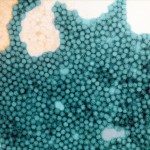Link to Pubmed [PMID] – 2278877
Cell Growth Differ. 1990 Oct;1(10):463-72
The int-2 protein is related to basic fibroblast growth factor (bFGF) by amino acid sequence homology. To assess its biological activity, we constructed retroviral vectors containing four variants of mouse int-2 complementary DNA under the transcriptional control of the beta-actin promoter and tested their effects on human SW13 adrenal cortical tumor cells. This cell line specifically requires bFGF, interleukin 1, or transforming growth factor e for anchorage-independent growth in soft agar. Despite encoding a signal sequence that should direct the protein to the secretory pathway, vectors containing unmodified int-2 complementary DNA, or a form optimized for translation initiation at the AUG codon, were incapable of inducing SW13 growth in soft agar. However, SW13 transfectants expressing a construct (pSP1), in which a mouse immunoglobulin signal peptide sequence is linked to the int-2 coding sequences, grew well in soft agar. The concentrated conditioned medium from these pSP1-transfected cells supported anchorage-independent growth of SW13 indicator cells and competed with bFGF for binding to receptors. Western blot analysis with an int-2-specific antiserum detected Mr 30,000-32,000 int-2 products in cell extracts and conditioned medium from pSP1-transfected clones, whereas the conditioned medium from these and other SW13 clones contained only low levels of bFGF as measured in a specific radioimmunoassay. These data suggest that the product of the int-2 gene can functionally replace bFGF in modulating the anchorage-independent growth of SW13 cells.

